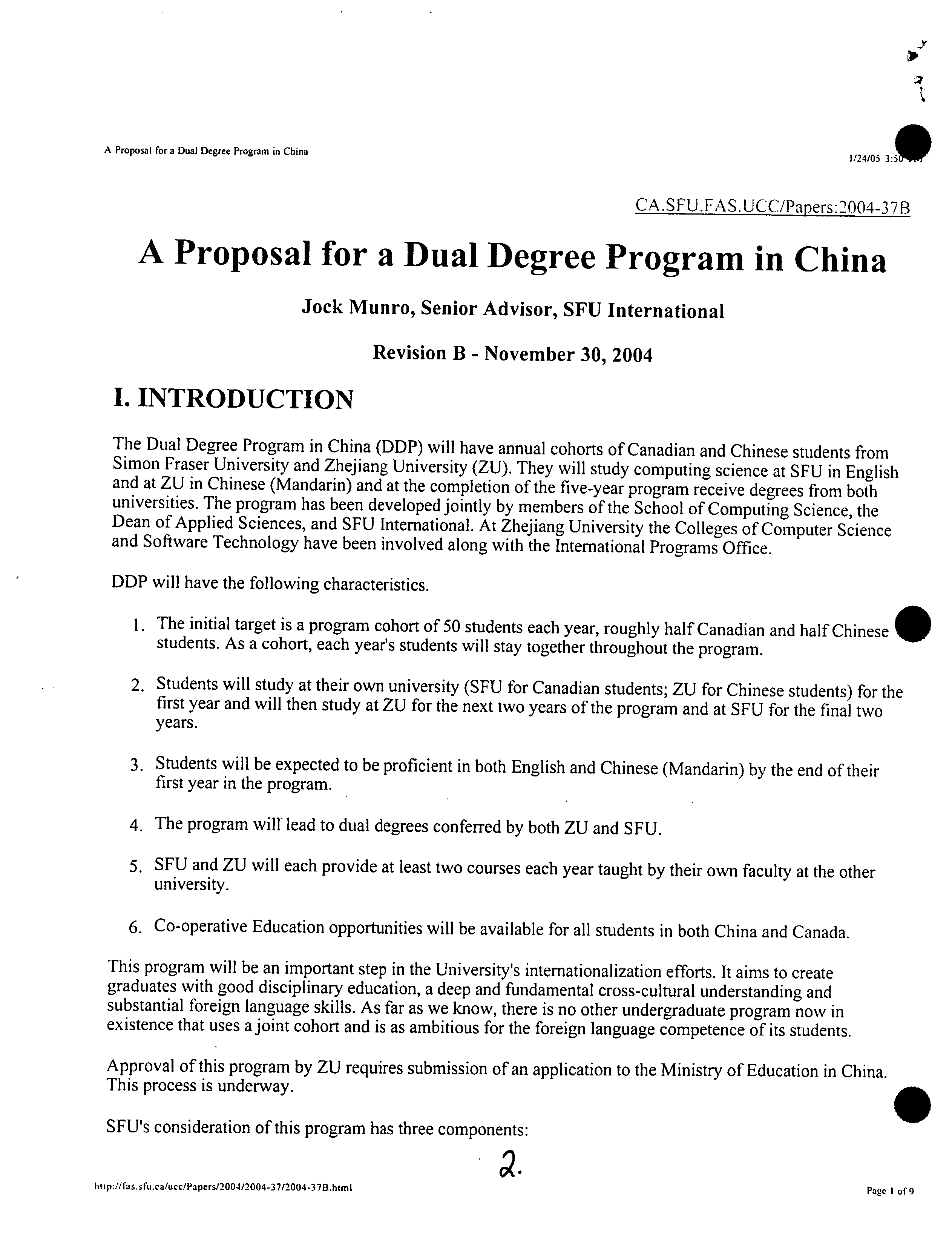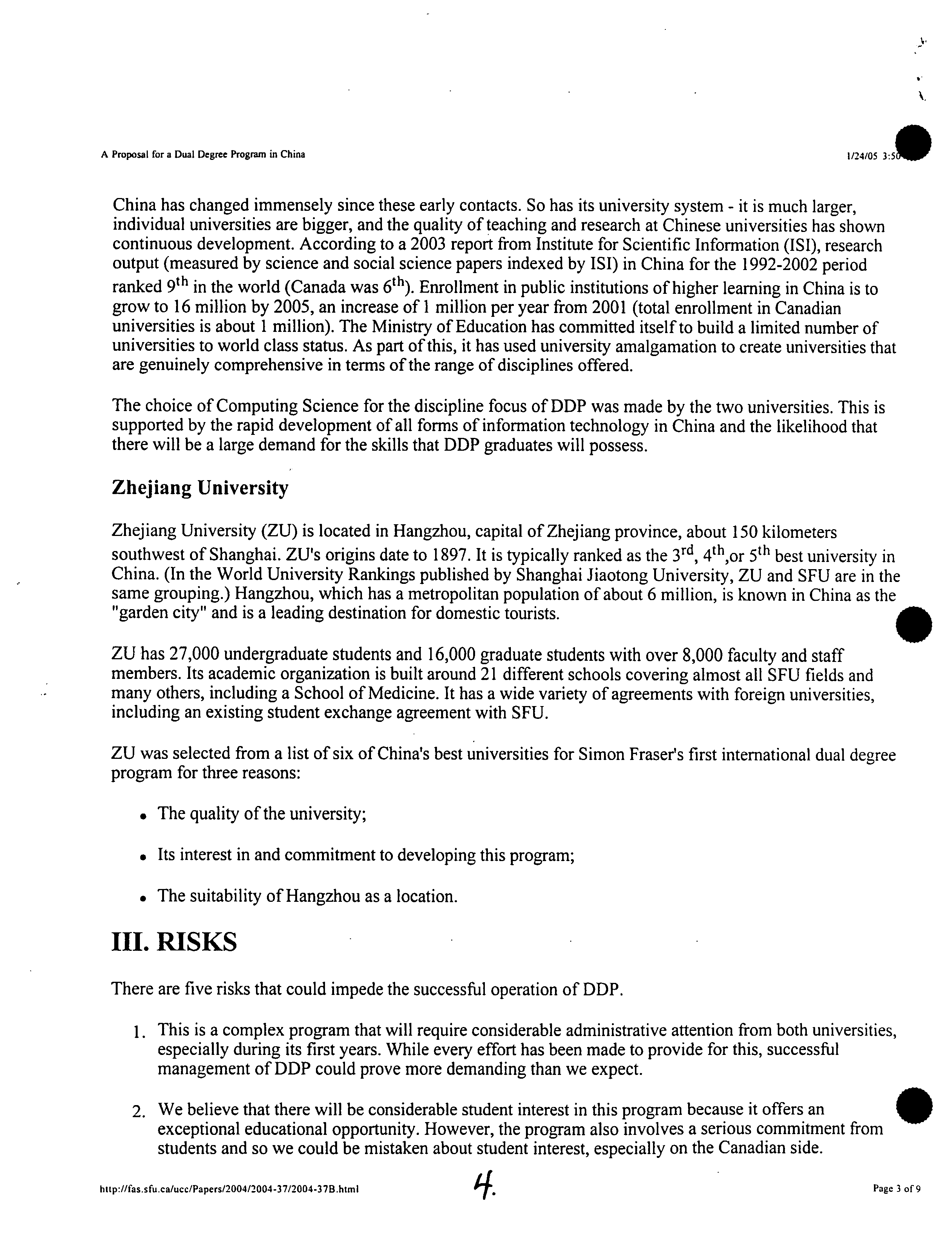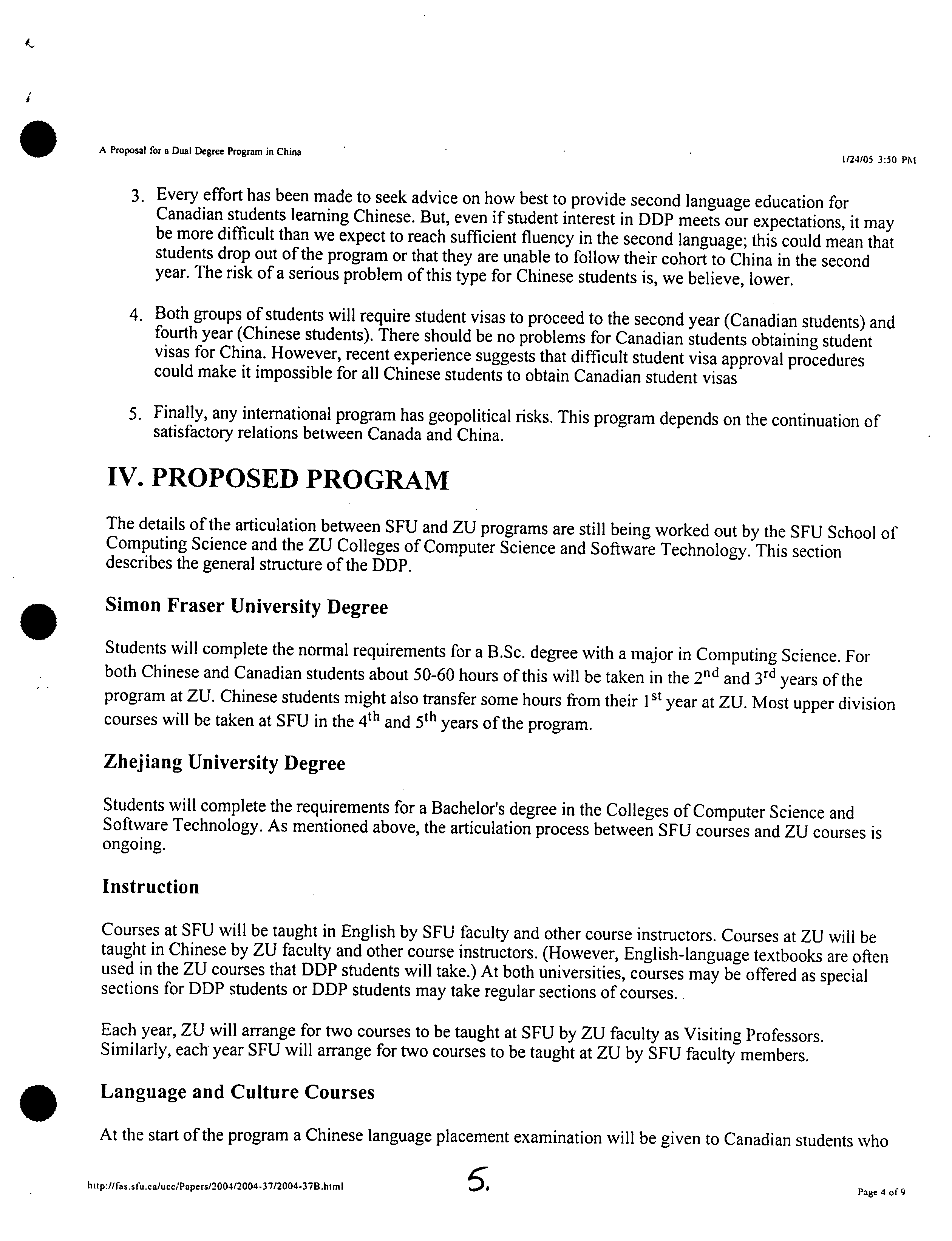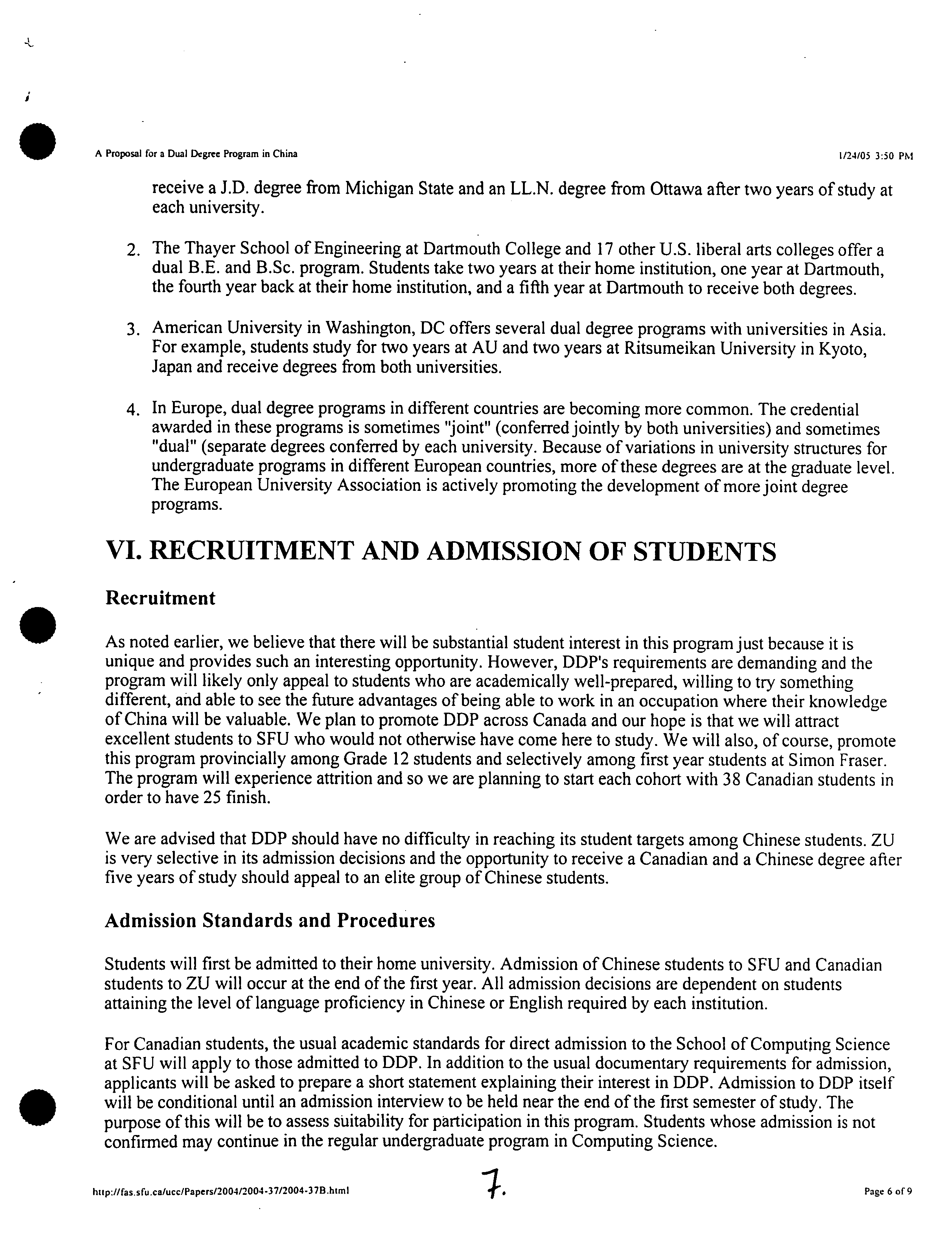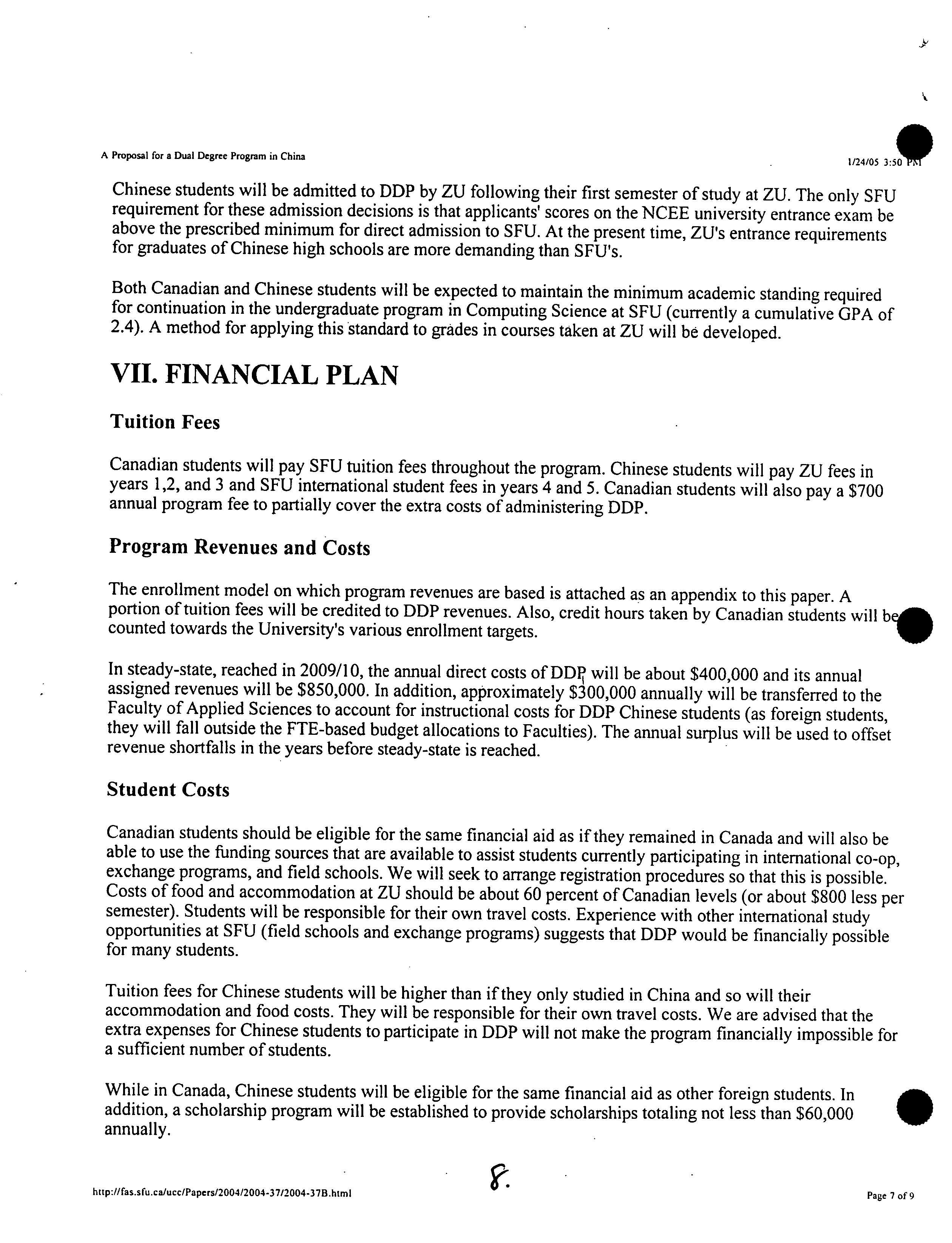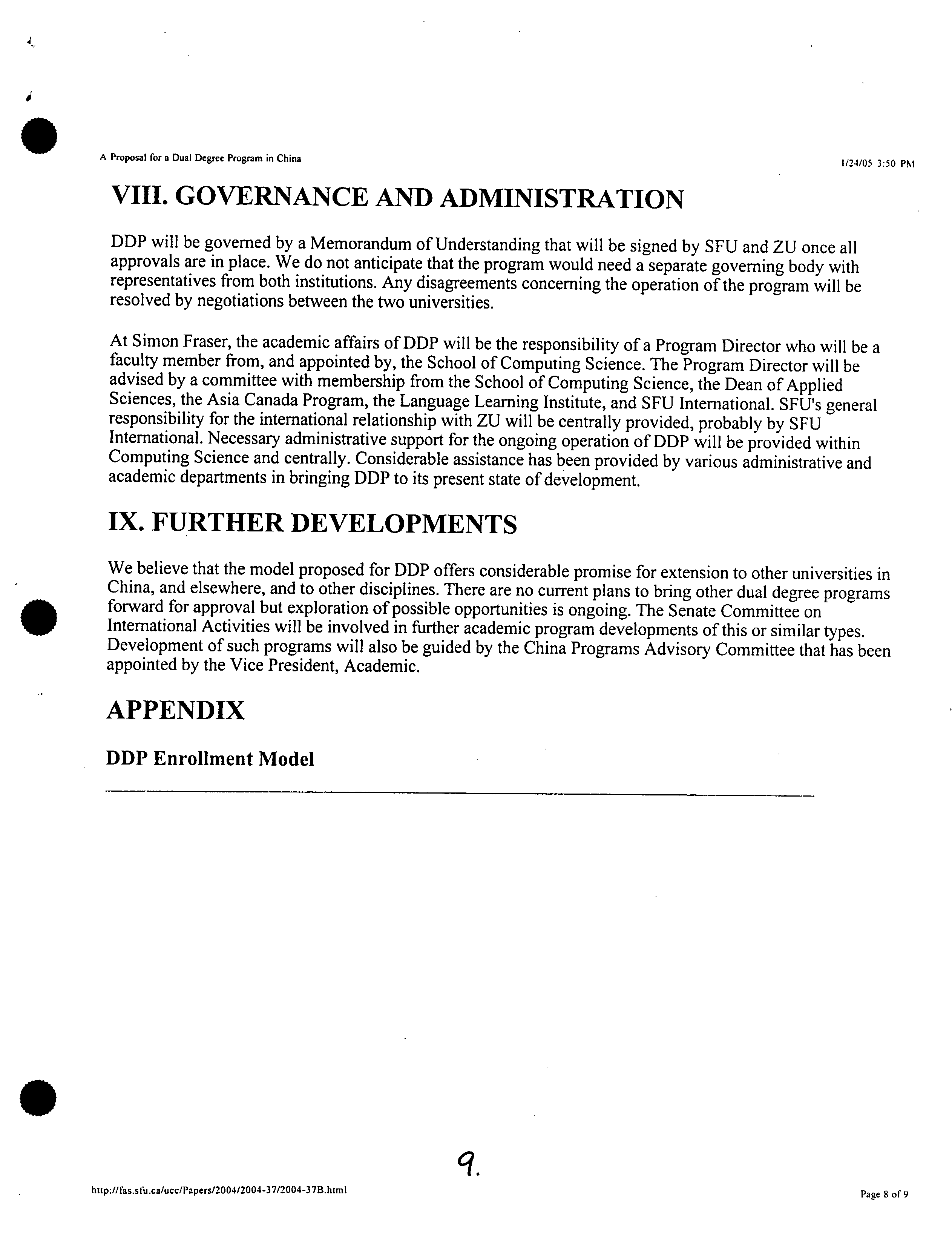S.05-27
SIMON FRASER UNIVERSITY
Senate Committee on University Priorities
?
Memorandum
TO:
Senate
?
FROM:
RE:
Dual Degree Program in China ?
DATE:
John Water
Chair, SCU
Vice-Presid
January 21,
At its January 12, 2005 meeting the Senate Committee on University Priorities (SCUP)
recommended the following motion:
Motion
That Senate approve and recommend to the Board of Governors the proposal for a
Dual Degree Program in China, in the Faculty of Applied Sciences.
end.
C: R. Blackman ?
J. Munro
G. Nicholls
0
4
4
S
?
SIMON FRASER UNIVERSITY
MEMORANDUM
To: ?
Senate Committee on University Priorities
From:
?
R.
Blackman, Chair
Senate Committee on Undergraduate Studies
Subject: ?
Faculty of Applied Sciences
Proposal for a Dual Degree Program in China
(SCUS Reference: SCUS 04-32)
Date: ?
December 15, 2004
At
the SCUS meeting held on December 14, 2004, SCUS approved in principle and
recommended approval by SCUP of the proposal for a Dual Degree Program in China.
The relevant documentation is attached for review by SCUP.
FJ
1.
5.
A Proposal for a Dual Degree Program in China
?
1/24/05 3:
CA.SFU.FAS. UCC/Papers:2004-37B
A Proposal for a Dual Degree Program in China
Jock Munro, Senior Advisor, SFU International
?
Revision B - November 30, 2004
I. INTRODUCTION
The Dual Degree Program in China (DDP) will have annual cohorts of Canadian and Chinese students from
Simon Fraser University and Zhejiang University (ZU). They will study computing science at SFU in English
and at ZU in Chinese (Mandarin) and at the completion of the five-year program receive degrees from both
universities. The program has been developed jointly by members of the School of Computing Science, the
Dean of Applied Sciences, and SFU International. At Zhejiang University the Colleges of Computer Science
and Software Technology have been involved along with the International Programs Office.
DDP will have the following characteristics.
1.
The initial target is a program cohort of
50
students each year, roughly half Canadian and half Chinese
students. As a cohort, each year's students will stay together throughout the program.
2.
Students will study at their own university (SFU for Canadian students; ZU for Chinese students) for the
first year and will then study at ZU for the next two years of the program and at SFU for the final two
years.
3.
Students will be expected to be proficient in both English and Chinese (Mandarin) by the end of their
first year in the program.
4.
The program will lead to dual degrees conferred by both ZU and SFU.
5.
SFU and ZU will each provide at least two courses each year taught by their own faculty at the other
university.
6.
Co-operative Education opportunities will be available for all students in both China and Canada.
This program will be an important step in the University's internationalization efforts. It aims to create
graduates with good disciplinary education, a deep and fundamental cross-cultural understanding and
substantial foreign language skills. As far as we know, there is no other undergraduate program now in
existence that uses a joint cohort and is as ambitious for the foreign language competence of its students.
Approval of this program by ZU requires submission of an application to the Ministry of Education in China.
This process is underway.
SFU's consideration of this program has three components:
lit p:i/fus.s fu.
ca/ucc/Papers/2004/2004-37/20O4.37B.h,mI
?
Page I
of 9
0 ?
A Proposal for a Dual Degree Program in China
?
1/2405 3:50 PM
1.
Acceptance of approximately 60 hours of ZU courses as transfer credit towards a B.Sc. with a major in
Computing Science. This is presently being considered by the School of Computing Science and will not
require other approval.
2.
Approval to operate this international program given by the President on the recommendation of the
Senate Committee on International Activities (SCIA). Information concerning DDP has been provided to
SCIA at several meetings. Formal consideration by SCIA is expected to occur at its meeting in January,
2005.
3.
Approval for students receiving two degrees for approximately 150 hours of course credit in a five-year
program. This requires Senate approval. This paper has been prepared to provide full information about
DDP in support of this request.
II. RATIONALE
General Rationale
Internationalization of higher education in Canada has become an imperative as global forces reduce the size
of the world and increase the need for culturally informed graduates. The universality of knowledge in the
information age, the competitive nature of world trade and the increasing rate of cultural exchange dictate that
the international dimension of higher education must keep pace with changes occurring globally.
. ?
Internationalization is therefore essential for the University to fulfil its mandate to create and share knowledge
and to provide a learning environment that prepares students, faculty, and staff to function effectively in an
increasingly integrated, global environment.
Developing global citizens through higher education requires real global experience. Enriched understanding
of languages, cultures and the complex and important global processes described above requires immersion in
foreign cultures and their academic institutions in non-English speaking countries. Already, SFU graduates
who have participated in international activities will have academic, language and cultural skills that would not
be possible from studying at SFU in Canada. These attributes would be increased and enhanced through
increased frequency and duration of academic activity and everyday life outside Canada.
Evidence shows the value of cross-cultural student interaction in both formal and non-formal collegial
situations in terms of assimilation of culture and language, especially when the exposure to new language and
culture is lengthy and deep. Most student exchange programs are typically one or two semesters long and field
schools are normally one semester in duration. In both cases instruction is largely in English and field schools
do not usually provide an opportunity for prolonged interaction between SFU students and host country
students. A deeper impact would be obtained from a Simon Fraser University program in part offered outside
Canada, in cooperation with a like-minded institution of similar academic quality, where Canadian and host
country students would study together in both the host country language and in English.
China
China has been selected as the host country for DDP because of its enormous historical, cultural, political and
economic importance. Simon Fraser University has been interested in program development opportunities in
. ?
China for over 20 years. Our first international exchange agreement was with Jinan University in Guanghzou,
China, signed by President Pedersen in 1982 and our first university mission to explore overseas exchange
opportunities was to China in 1983. A considerable number of projects and programs have been carried out
with Chinese institutions since then.
hitp://fas.sfu.ca/ucc/Papers/2004/2004-3712004-37B.html
?
3.
?
Page 2 of 9
A Proposal for a Dual Degree Program in China
?
1/24/05 3:51I
China has changed immensely since these early contacts. So has its university system - it is much larger,
individual universities are bigger, and the quality of teaching and research at Chinese universities has shown
continuous development. According to a 2003 report from Institute for Scientific Information (ISI), research
output (measured by science and social science papers indexed by ISI) in China for the 1992-2002 period
ranked
9th
in the world (Canada was
6th).
Enrollment in public institutions of higher learning in China is to
grow to 16 million by 2005, an increase of I million per year from 2001 (total enrollment in Canadian
universities is about 1 million). The Ministry of Education has committed itself to build a limited number of
universities to world class status. As part of this, it has used university amalgamation to create universities that
are genuinely comprehensive in terms of the range of disciplines offered.
The choice of Computing Science for the discipline focus of DDP was made by the two universities. This is
supported by the rapid development of all forms of information technology in China and the likelihood that
there will be a large demand for the skills that DDP graduates will possess.
Zhejiang University
Zhejiang University (ZU) is located in Hangzhou, capital of Zhejiang province, about 150 kilometers
southwest of Shanghai. ZU's origins date to 1897. It is typically ranked as the
3 rd
, 4th,or
5th best university in
China. (In the World University Rankings published by Shanghai Jiaotong University, ZU and SFU are in the
same grouping.) Hangzhou, which has a metropolitan population of about 6 million, is known in China as the
ZU
"garden
has 27,000
city" and
undergraduate
is a leading destination
students and
for
16,000
domestic
graduate
tourists.students
?
with over 8,000 faculty and staff
0
members. Its academic organization is built around 21 different schools covering almost all SFU fields and
many others, including a School of Medicine. It has a wide variety of agreements with foreign universities,
including an existing student exchange agreement with SFU.
ZU was selected from a list of six of China's best universities for Simon Fraser's first international dual degree
program for three reasons:
• The quality of the university;
• Its interest in and commitment to developing this program;
• The suitability of Hangzhou as a location.
III. RISKS
There are five risks that could impede the successful operation of DDP.
1.
This is a complex program that will require considerable administrative attention from both universities,
especially during its first years. While every effort has been made to provide for this, successful
management of DDP could prove more demanding than we expect.
2.
We believe that there will be considerable student interest in this program because it offers an
exceptional educational opportunity. However, the program also involves a serious commitment from
students and so we could be mistaken about student interest, especially on the Canadian side.
hltp://fas.sfu.ca/ucc/Papers/2004/2004-37/2004-37B.html
?
'/. ?
Page 3 of 9
S
?
A Proposal for a Dual Degree Program in China
?
1/24/05 3:50 PM
3.
Every effort has been made to seek advice on how best to provide second language education for
Canadian students learning Chinese. But, even if student interest in DDP meets our expectations, it may
be more difficult than we expect to reach sufficient fluency in the second language; this could mean that
students drop out of the program or that they are unable to follow their cohort to China in the second
year. The risk of a serious problem of this type for Chinese students is, we believe, lower.
4.
Both groups of students will require student visas to proceed to the second year (Canadian students) and
fourth year (Chinese students). There should be no problems for Canadian students obtaining student
visas for China. However, recent experience suggests that difficult student visa approval procedures
could make it impossible for all Chinese students to obtain Canadian student visas
5.
Finally, any international program has geopolitical risks. This program depends on the continuation of
satisfactory relations between Canada and China.
IV. PROPOSED PROGRAM
The details of the articulation between SFU and ZU programs are still being worked out by the SFU School of
Computing Science and the ZU Colleges of Computer Science and Software Technology. This section
describes the general structure of the DDP.
Simon Fraser University Degree
Students will complete the normal requirements for a B.Sc. degree with a major in Computing Science. For
both Chinese and Canadian students about
50-60
hours of this will be taken in the
2nd
and 31 years of the
program at ZU. Chinese students might also transfer some hours from their
I
st
year at ZU. Most upper division
courses will be taken at SFU in the
4th
and
51h
years of the program.
Zhejiang University Degree
Students will complete the requirements for a Bachelor's degree in the Colleges of Computer Science and
Software Technology. As mentioned above, the articulation process between SFU courses and ZU courses is
ongoing.
Instruction
Courses at SFU will be taught in English by SFU faculty and other course instructors. Courses at ZU will be
taught in Chinese by ZU faculty and other course instructors. (However, English-language textbooks are often
used in the ZU courses that DDP students will take.) At both universities, courses may be offered as special
sections for DDP students or DDP students may take regular sections of courses..
Each year, ZU will arrange for two courses to be taught at SFU by ZU faculty as Visiting Professors.
Similarly, each year SFU will arrange for two courses to be taught at ZU by SFU faculty members.
Language and Culture Courses
S
r
At the start of the program a Chinese language placement examination will be given to Canadian students who
http://fas.slu.eaiucc/Papers/2004/2004-37/2004-37B.html ?
• ?
Page 4 of9
A Proposal for a Dual Degree Program in China
?
1/24105
3:3
already have some facility in the Chinese language. Canadian students who have no Chinese will complete 15
hours of Chinese language courses in their first two semesters (one course in the fall and three courses in the
spring) and take a semester-long Chinese language immersion course at ZU in the summer semester of their
first year. We have received advice from several sources that this should be enough to equip Canadian students
with adequate language fluency to take courses taught in Chinese beginning in the fall of their second year in
the program. Students will take a language proficiency test before beginning the immersion course at ZU.
We expect the Chinese students to enter the program with a relatively higher level of English language
proficiency than Canadian students' proficiency in Chinese. Chinese students will take an additional three
English language courses before coming to take courses at SFU in English. Students will be expected to meet
SFU's TOEFL or IELTS standards.
For Canadian students the curriculum will include courses in Chinese culture, society, politics, and history
taught both at SFU and ZU. We are exploring the best ways of providing similar courses about Canada for
Chinese students. The joint student cohorts will provide excellent social opportunities for learning about each
other's countries. We plan to begin this process with a web site during the first year of the program.
Co-operative Education
DDP will offer optional co-operative education opportunities in both China and Canada for both Canadian and
Chinese students. We are considering ways to arrange the three co-op semesters that will be necessary for
students to receive a co-op certificate.
Leaving the Program
Students who decide to leave the program will be able to transfer their credits to the same or other programs at
SFU according to normal University regulations.
Some students may fall behind their cohort. Where this lag is minor, every reasonable effort will be made to
keep the student in the same cohort. If this is impossible, the student should be able to join the next year's
cohort. Implementation details will be established later.
V. DUAL DEGREES
Students will receive two degrees, one from each university, for completing the requirements of DDP. The
general rationale for dual degrees is that combining study in two institutions or two fields accelerates the
learning process and so allows students to learn more in a similar time period. Most dual degree programs,
including this one, require more time for the two degrees, but less than twice as much. DDP students will
receive degrees from both SFU and ZU with approximately 150 credit hours.
SFU has many examples of the dual degree "principle". The most pertinent is the general rule at SFU that
students can receive a second degree by completing the required 45 hours of upper division credit in a different
field than the first degree.
There are numerous world examples of what is being proposed for DDP. Some examples follow.
I. Michigan State University and the University of Ottawa offer a dual degree program in law. Students
htp://fas.sfu.ca/ucc/Papers/2004/2004-37/2004-37B.h*ml ?
Page 5 of9
II
0 ?
A Proposal for a Dual Degree Program in China
?
1124/05
3:50 PM
receive a J.D. degree from Michigan State and an LL.N. degree from Ottawa after two years of study at
each university.
2.
The Thayer School of Engineering at Dartmouth College and 17 other U.S. liberal arts colleges offer a
dual B.E. and B.Sc. program. Students take two years at their home institution, one year at Dartmouth,
the fourth year back at their home institution, and a fifth year at Dartmouth to receive both degrees.
3.
American University in Washington, DC offers several dual degree programs with universities in Asia.
For example, students study for two years at AU and two years at Ritsumeikan University in Kyoto,
Japan and receive degrees from both universities.
4.
In Europe, dual degree programs in different countries are becoming more common. The credential
awarded in these programs is sometimes "joint" (conferred jointly by both universities) and sometimes
"dual" (separate degrees conferred by each university. Because of variations in university structures for
undergraduate programs in different European countries, more of these degrees are at the graduate level.
The European University Association is actively promoting the development of more joint degree
programs.
VI. RECRUITMENT AND ADMISSION OF STUDENTS
Recruitment
As noted earlier, we believe that there will be substantial student interest in this program just because it is
unique and provides such an interesting opportunity. However, DDP's requirements are demanding and the
program will likely only appeal to students who are academically well-prepared, willing to try something
different, and able to see the future advantages of being able to work in an occupation where their knowledge
of China will be valuable. We plan to promote DDP across Canada and our hope is that we will attract
excellent students to SFU who would not otherwise have come here to study. We will also, of course, promote
this program provincially among Grade 12 students and selectively among first year students at Simon Fraser.
The program will experience attrition and so we are planning to start each cohort with 38 Canadian students in
order to have
25
finish.
We are advised that DDP should have no difficulty in reaching its student targets among Chinese students. ZU
is very selective in its admission decisions and the opportunity to receive a Canadian and a Chinese degree after
five years of study should appeal to an elite group of Chinese students.
Admission Standards and Procedures
Students will first be admitted to their home university. Admission of Chinese students to SFU and Canadian
students to ZU will occur at the end of the first year. All admission decisions are dependent on students
attaining the level of language proficiency in Chinese or English required by each institution.
For Canadian students, the usual academic standards for direct admission to the School of Computing Science
at SFU will apply to those admitted to DDP. In addition to the usual documentary requirements for admission,
applicants will be asked to prepare a short statement explaining their interest in DDP. Admission to DDP itself
.
?
will be conditional until an admission interview to be held near the end of the first semester of study. The
purpose of this will be to assess suitability for participation in this program. Students whose admission is not
confirmed may continue in the regular undergraduate program in Computing Science.
htlp://fas.sfu.ca/ucc/P2pers/2004/2004-37/2004-37B.html ?
•
?
Page 6 of 9
A Proposal for a Dual Degree Program in China
?
1/24105
3:50
Chinese students will be admitted to DDP by ZU following their first semester of study at ZU. The only SFU
requirement for these admission decisions is that applicants' scores on the NCEE university entrance exam be
above the prescribed minimum for direct admission to SFU. At the present time, ZU's entrance requirements
for graduates of Chinese high schools are more demanding than SFU's.
Both Canadian and Chinese students will be expected to maintain the minimum academic standing required
for continuation in the undergraduate program in Computing Science at SFU (currently a cumulative GPA of
2.4). A method for applying this standard to grades in courses taken at ZU will be developed.
VII. FINANCIAL PLAN
Tuition Fees
Canadian students will pay SFU tuition fees throughout the program. Chinese students will pay ZU fees in
years 1,2, and 3 and SFU international student fees in years 4 and
5.
Canadian students will also pay a $700
annual program fee to partially cover the extra costs of administering DDP.
Program Revenues and Costs
The enrollment model on which program revenues are based is attached as an appendix to this paper. A
portion of tuition fees will be credited to DDP revenues. Also, credit hours taken by Canadian students will b
counted towards the University's various enrollment targets.
?
0
In steady-state, reached in 2009/10, the annual direct costs of DDP, will be about $400,000 and its annual
assigned revenues will be
$850,000.
In addition, approximately $300,000 annually will be transferred to the
Faculty of Applied Sciences to account for instructional costs for DDP Chinese students (as foreign students,
they will fall outside the FTE-based budget allocations to Faculties). The annual surplus will be used to offset
revenue shortfalls in the years before steady-state is reached.
Student Costs
Canadian students should be eligible for the same financial aid as if they remained in Canada and will also be
able to use the funding sources that are available to assist students currently participating in international co-op,
exchange programs, and field schools. We will seek to arrange registration procedures so that this is possible.
Costs of food and accommodation at ZU should be about 60 percent of Canadian levels (or about $800 less per
semester). Students will be responsible for their own travel costs. Experience with other international study
opportunities at SFU (field schools and exchange programs) suggests that DDP would be financially possible
for many students.
Tuition fees for Chinese students will be higher than if they only studied in China and so will their
accommodation and food costs. They will be responsible for their own travel costs. We are advised that the
extra expenses for Chinese students to participate in DDP will not make the program financially impossible for
a sufficient number of students.
While in Canada, Chinese students will be eligible for the same financial aid as other foreign students. In
addition, a scholarship program will be established to provide scholarships totaling not less than $60,000
annually.
hctp://fas.sfuca/uccfPapers/2004/2004.37/200437Bh,ml
?
Page 7 of 9
A Proposal for a Dual Degree Program in China
?
1124/05
3:50 PM
VIII.
GOVERNANCE AND ADMINISTRATION
DDP will be governed by a Memorandum of Understanding that will be signed by SFU and ZU once all
approvals are in place. We do not anticipate that the program would need a separate governing body with
representatives from both institutions. Any disagreements concerning the operation of the program will be
resolved by negotiations between the two universities.
At Simon Fraser, the academic affairs of DDP will be the responsibility of a Program Director who will be a
faculty member from, and appointed by, the School of Computing Science. The Program Director will be
advised by a committee with membership from the School of Computing Science, the Dean of Applied
Sciences, the Asia Canada Program, the Language Learning Institute, and SFU International. SFU's general
responsibility for the international relationship with ZU will be centrally provided, probably by SFU
International. Necessary administrative support for the ongoing operation of DDP will be provided within
Computing Science and centrally. Considerable assistance has been provided by various administrative and
academic departments in bringing DDP to its present state of development.
IX.
FURTHER DEVELOPMENTS
We believe that the model proposed for DDP offers considerable promise for extension to other universities in
China, and elsewhere, and to other disciplines. There are no current plans to bring other dual degree programs
. ?
forward for approval but exploration of possible opportunities is ongoing. The Senate Committee on
International Activities will be involved in further academic program developments of this or similar types.
Development of such programs will also be guided by the China Programs Advisory Committee that has been
appointed by the Vice President, Academic.
APPENDIX
DDP Enrollment Model
I—
L-1
htip:/Ifas.sfu.calucclPapers/2004/2004-37/2004-37B.html ?
Page 8 of 9
A
Proposal
for a Dual Degree Program in China
CD=Canadian
students;
CNChinese students
ICD Enrollment Year 1
2005/06
2006/07
1b8 ?
j138
FF7^2007/08
[38
1138 ?
138
2011/12IF012/]3i
138 ?
]J38jJ38
1132
?
1L
32
132
132
I32
IF
32
-
1132
lcD
I
E
nrollment
o
JXi
Year 4
JI29
126
?
i1
li
29
L2'LLJL
26
J1 26
J26
Lc
nt
Year
5
ITotal
_____
?
II
?
l{5
17° ?
IL
99 ?
1125
1150
11_iI_J1_
11
150 ?
1 150
?
11150
Ic
i
J[8
JCN
[CN
Enrollment
Enrollment Year
Year 2
3
1133
133. ?
133 ?
1L3.3
32
?
1[iI_JI_
J^Enrollment Year
____
ff
J.l_
II
125 ?
11
JL___iI.
_____
38 ?
71
?
[103
1129
1154
?
lft.J__iL54
[Total Students ?
76
?
141 ?
II
202 ?
]54
11304
?
Q
113
1Ti
J
38
11 38
11 38
____________
140
____________
140
140
140
11 103
1164
?
11
164
I
1L164
164J!i64
1/24105
3:5
10.
liitp:I/fas.sfu.ca/ucc/Papers/200412004-3712004-37B.html ?
Page 9 of



